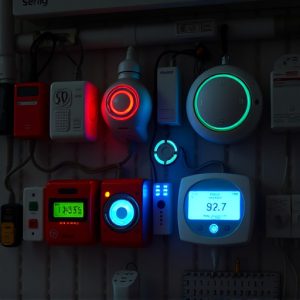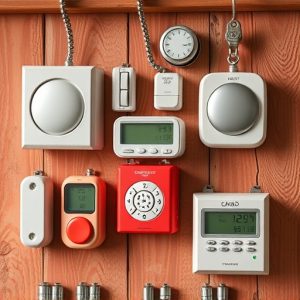Lone Worker Safety: Personal Alarms with Strobe Lights for Enhanced Protection
Lone workers face unique risks without immediate assistance, making effective safety measures crucia…….
Lone workers face unique risks without immediate assistance, making effective safety measures crucial. Personal alarms with strobe lights are vital tools, providing visual and auditory signals to alert others to distress. These devices combine flashing lights, loud sirens, vibration alerts, GPS tracking, and automatic fall detection for multi-faceted protection. Implementing these alarms enhances response times, improves visibility in low-light conditions, and fosters a proactive safety culture, ultimately safeguarding lone workers on job sites across diverse industries.
In today’s diverse work environment, lone workers face unique challenges, making it crucial to implement robust safety alert systems. This article explores the critical role of these systems in safeguarding isolated individuals, focusing on personal alarms with strobe lights as a game-changer. We delve into understanding the risks, the effectiveness of such alarms, and their practical implementation on job sites through real-world case studies. By examining these aspects, we highlight how these systems can revolutionize safety for lone workers.
- Understanding the Risks Faced by Lone Workers
- The Role of Personal Alarms in Safety Alert Systems
- Features of a High-Effective Personal Alarm With Strobe Light
- Implementing and Using Safety Alert Systems on the Job Site
- Case Studies: Successful Implementation and Impact
Understanding the Risks Faced by Lone Workers
Lone workers, by definition, operate independently and without direct supervision. This can expose them to unique risks that don’t exist in collaborative work environments. They may be more vulnerable to accidents, injuries, or even hostile situations due to a lack of immediate assistance or oversight. Understanding these risks is the first step in implementing effective safety measures.
One crucial tool in mitigating these dangers is a personal alarm with strobe light. These devices serve as a loud visual signal that can attract attention and deter potential threats. A simple press of a button activates an ear-splitting alarm and flashing lights, alerting colleagues, emergency services, or even passing strangers to the wearer’s location and distress. This technology empowers lone workers by providing them with a quick and reliable way to request help when needed.
The Role of Personal Alarms in Safety Alert Systems
Personal alarms play a pivotal role in safety alert systems for lone workers, offering a crucial line of defense in high-risk environments. These compact yet powerful devices are designed to instantly capture attention and convey distress when activated. A key component of many personal alarms is the strobe light, which flashes rapidly to disrupt visual distractions and grab the immediate attention of nearby colleagues or emergency services.
The integration of a strobe light with other alert features, such as loud sirens and vibration, ensures that even in noisy or cluttered environments, the alarm is noticed. This functionality is particularly vital for lone workers who may be far from immediate assistance. Personal alarms with strobe lights provide a reliable means of communication, enabling workers to signal their location and emergency status effectively, thereby enhancing overall safety and response time.
Features of a High-Effective Personal Alarm With Strobe Light
A high-effective personal alarm with strobe light is an indispensable tool for lone workers, offering a multi-faceted safety net. Beyond just emitting a loud sound to alert others, these devices often incorporate advanced features like long-lasting batteries and water resistance, ensuring reliability in various environments. The strobe light component adds a crucial layer of visibility, especially in low-light conditions or when the worker is in a remote area, making it easier for rescuers or colleagues to locate them quickly.
Additionally, modern personal alarms may include GPS tracking capabilities, allowing supervisors to monitor the worker’s location in real time. Some models even feature automatic fall detection and emergency buttons that can send out alerts upon activation, providing immediate assistance. These features collectively enhance the safety and peace of mind for lone workers, ensuring that help is readily available when needed.
Implementing and Using Safety Alert Systems on the Job Site
Implementing and using safety alert systems, such as personal alarms with strobe lights, is a vital step in ensuring the well-being of lone workers on any job site. These devices serve as a critical line of defense against potential hazards and emergencies, providing both visibility and peace of mind. When selecting an appropriate system, consider factors like ease of use, battery life, and environmental durability to ensure maximum effectiveness.
Training employees on how and when to activate these alerts is equally crucial. Regular drills and demonstrations can help familiarize workers with the equipment, fostering a culture of proactive safety measures. Additionally, integrating these systems with existing communication protocols enhances overall responsiveness during emergencies, ultimately creating a safer working environment for isolated personnel.
Case Studies: Successful Implementation and Impact
In recent years, numerous organizations have successfully implemented safety alert systems featuring personal alarms with strobe lights for lone workers, leading to significant improvements in worker safety and peace of mind. These case studies highlight the transformative power of such technologies in remote or isolated work environments. For instance, a logging company in North America faced challenges ensuring the safety of its forest workers operating alone in rugged terrain. After introducing personal alarms equipped with strobe lights, they witnessed a dramatic drop in incident rates, allowing workers to quickly signal distress or emergencies from afar.
Another compelling example involves a maintenance team in a large industrial facility where employees frequently worked in confined spaces or hazardous conditions. The implementation of these advanced personal alarms resulted in improved response times and better overall situational awareness. In one notable case, a worker’s strobe light signal promptly alerted colleagues to an impending gas leak, preventing a potential disaster. These successful implementations underscore the value of integrating personal alarm systems with strobe lights into safety protocols for lone workers across various industries.
Lone workers face unique risks, but implementing safety alert systems, particularly those featuring a personal alarm with strobe light, can significantly enhance their protection. These devices not only provide immediate alerts in emergencies but also serve as a constant reminder of the need for caution. Through proper training and consistent use, job sites can create a safer environment for lone workers, as evidenced by successful case studies. Investing in effective safety alert systems is a crucial step towards mitigating risks and ensuring the well-being of these essential individuals.


